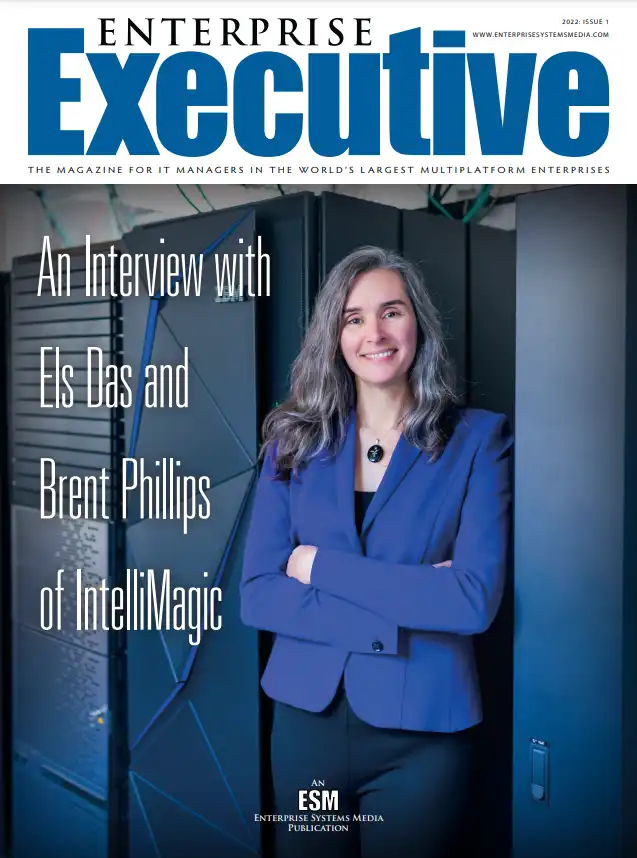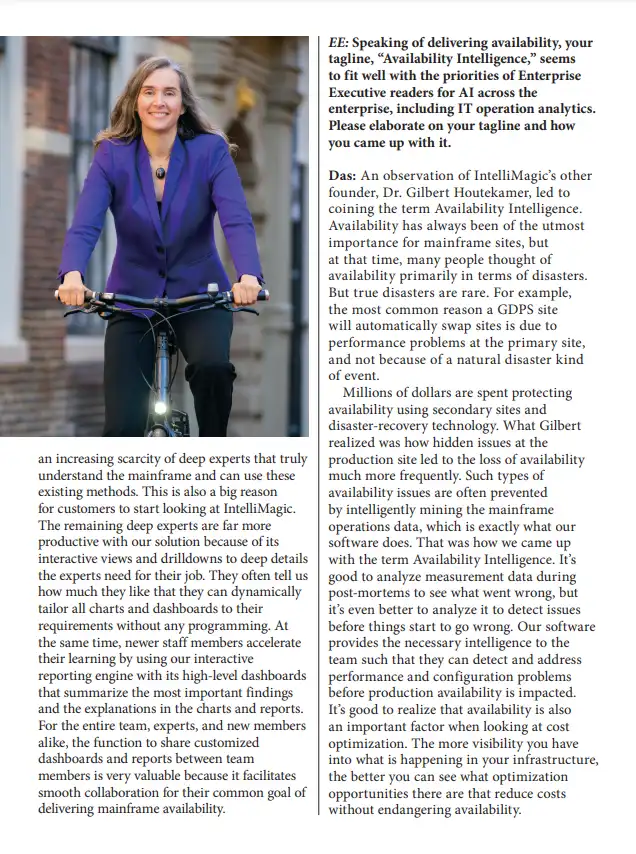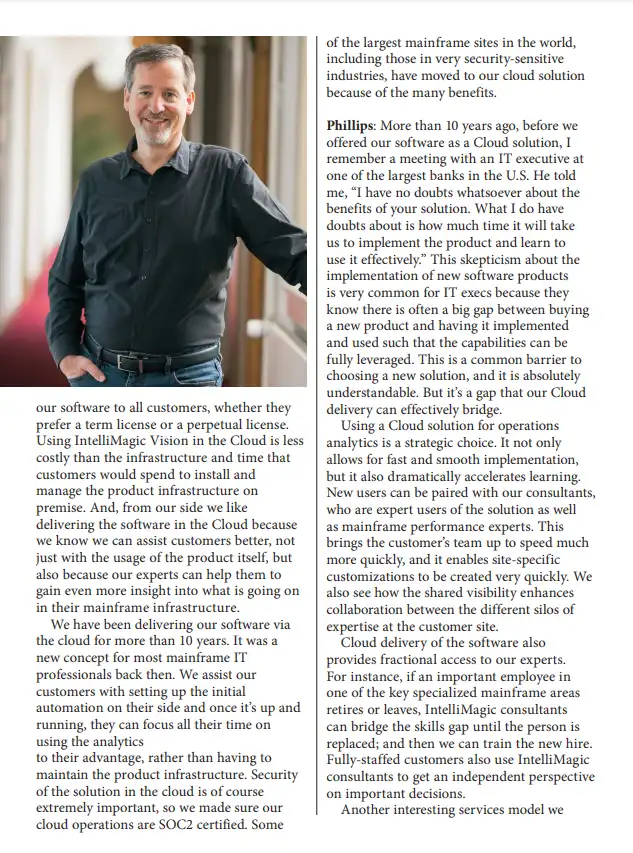By Denny Yost

Enterprise Executive: IntelliMagic has established a presence at some of the largest and most demanding mainframe sites in the world with your z/OS operations analytics solution. How did you do this?
Els Das: Let me start by saying that we are proud of all our customers, large or small, and grateful for all of them. We deliver the same high-quality service to all our customers regardless of their size or the complexity of their environment. The companies at the top end are indeed often not the easiest to win over, but we really benefit from interacting with customers that manage a demanding environment. Understanding their daily challenges helps us to develop the most valuable solution for everyone. As to why companies choose to work with us, I like to think that the personal attention, human expertise and responsiveness from everyone in our company, combined with our intelligent solution that is continuously expanded, are instrumental in capturing the attention and retaining long term relationships with customers.
As a background, I would like to provide a little history of IntelliMagic. We started IntelliMagic in 2002 as a management buy-out from a company called Consul Risk Management that Dr. Gilbert Houtekamer, the other founder of IntelliMagic, had co-founded in the late 1980s. As IntelliMagic, we initially offered performance management software for mainframe attached storage. One of the Consul products we took over was the storage modeling solution called Disk Magic that IBM licensed. The credibility and name recognition from that product helped us get into the door at some large customer sites in the early years of IntelliMagic.
At that time, mainframe storage contained hidden bottlenecks such as spinning disks that could suddenly and drastically impact performance. Our solution was the best in the world for detecting and preventing those issues. As we grew over the years, we broadened the solution to cover many other areas of the mainframe infrastructure, and we evolved the product to a true IT operations analytics solution for the z/OS platform. We now support a broad scope of mainframe areas, giving our customers end-to-end visibility on all the key CPU and Systems components as well as storage, CICS, Db2, MQ, TCP/IP, and other areas.
Brent Phillips: As Els said, we have customers across the size spectrum and from many different industries. The challenges of delivering continuous infrastructure availability for optimal cost are similar regardless of size. Small sites can even have additional challenges, as the size of the team is often not big enough to provide deep expertise into all the different infrastructure areas. That is where we offer additional value by making our deep mainframe experts available for our customers.
The z/OS platform is well known for its scalability, reliability and security. It’s also unique in that it offers the most elaborate and robust infrastructure operation measurements in the form of SMF and RMF (or CMF). This rich data source can be of immense value in protecting the availability of the entire infrastructure by finding hidden problems and quickly resolving issues. But the measurements must be interpreted by an expert for the value to be realized. This is impossible for even the largest and most experienced teams to do manually. Humans are not well suited for manually reviewing big data on a continuous basis to identify anomalous behavior and hidden issues. This is one of the key benefits where our solution helps.
If you look at the classical tools used to analyze mainframe measurement data, there is an increasing scarcity of deep experts that truly understand the mainframe and can use these existing methods. This is also a big reason for customers to start looking at IntelliMagic. The remaining deep experts are far more productive with our solution because of its interactive views and drilldowns to deep details the experts need for their job. They often tell us how much they like that they can dynamically tailor all charts and dashboards to their requirements without any programming. At the same time, newer staff members accelerate their learning by using our interactive reporting engine with its high-level dashboards that summarize the most important findings and the explanations in the charts and reports. For the entire team, experts, and new members alike, the function to share customized dashboards and reports between team members is very valuable because it facilitates smooth collaboration for their common goal of delivering mainframe availability.

Das: An observation of IntelliMagic’s other founder, Dr. Gilbert Houtekamer, led to coining the term Availability Intelligence. Availability has always been of the utmost importance for mainframe sites, but at that time, many people thought of availability primarily in terms of disasters. But true disasters are rare. For example, the most common reason a GDPS site will automatically swap sites is due to performance problems at the primary site, and not because of a natural disaster kind of event.
Millions of dollars are spent protecting availability using secondary sites and disaster-recovery technology. What Gilbert realized was how hidden issues at the production site led to the loss of availability much more frequently. Such types of availability issues are often prevented by intelligently mining the mainframe operations data, which is exactly what our software does. That was how we came up with the term Availability Intelligence. It’s good to analyze measurement data during post-mortems to see what went wrong, but it’s even better to analyze it to detect issues before things start to go wrong. Our software provides the necessary intelligence to the team such that they can detect and address performance and configuration problems before production availability is impacted. It’s good to realize that availability is also an important factor when looking at cost optimization. The more visibility you have into what is happening in your infrastructure, the better you can see what optimization opportunities there are that reduce costs without endangering availability.
Phillips: When we use the word intelligence, it means various things. There is the intelligence that is embedded throughout the software to create efficient and platform-aware RMF and SMF data collection, normalization, correlation, interpretation and visualization. Embedded z/OS specific expert knowledge is used to mine the enriched data for hidden issues. This is a powerful “force multiplier” that provides analytics that would not be humanly possible to create manually, even if someone would have all the expertise in the world. With this automated intelligence, risks to production availability are detected before they have an impact. Enabling faster mean-time-to-resolution (MTTR), in other words decreasing the period that an application or its users suffer from infrastructure unavailability, is another benefit of this automated intelligence.
This algorithmic approach to analyzing and interpreting the data creates clearly explainable results. Millions of values per hour are rated as being healthy or alarming, and to what degree. The explanations behind these ratings tell the team why something is worthy of attention. The experts really like this, as they take a “trust, but verify” approach to the machine decisions. And this explainability is very valuable for newer team members too because it helps them understand what is important to look at and why. We also have dynamic intelligence in our software that uses AI to perform anomaly and change detection which will, for instance, flag unexpected workload changes that are important to review because they may point to a runaway process or a new version of an application that has a sometimes unplanned change to its workload profile.
EE: You mentioned cost optimization as a part of the focus of your Availability Intelligence solution. How has the push for TFP (Tailored Fit Pricing) Software Consumption changed your reporting and analytics?
Phillips: IBM indeed seems to be strongly encouraging sites to move to a consumption-based software pricing model. Analytics solutions play an important role in identifying opportunities to optimize for various pricing plans. Consulting services are also a high leverage investment for these decisions. IntelliMagic, and also our partner Watson & Walker, have helped numerous sites evaluate and advise on whether TFP would be a good fit, and what to do to optimize for it. For many sites, it’s important to note that there are preparations that are important to make well before starting the TFP negotiation process.
Das: As you know, with the IBM TFP Software Consumption solution, all CPU consumption during the month matters, instead of just the four-hour peak period in the month. IntelliMagic Vision contains specialized support for this and helps understanding and analyzing enterprise consumption throughout the month. As a company, we always like to supply educational resources to anyone who is interested, so we made some detailed TFP educational materials available on the IntelliMagic website (https://www.intellimagic.com/). These can be found by going to the search under the “Resources” dropdown menu and search for the term TFP. There are several blogs, on-demand webinars, and reprints of a series of articles we wrote on this subject for the Watson & Walker Tuning Letter in 2021. We would love for your readers to look at these resources and get in touch to let us know what they think.
EE: How have services that you offer affected performance and capacity teams in their use of the z/OS operations data?
Das: The most significant impact we have with regards to services is delivering IntelliMagic Vision in the Cloud and combining it with assistance from our deep experts. We can offer the Cloud version of our software to all customers, whether they prefer a term license or a perpetual license. Using IntelliMagic Vision in the Cloud is less costly than the infrastructure and time that customers would spend to install and manage the product infrastructure on premise. And, from our side we like delivering the software in the Cloud because we know we can assist customers better, not just with the usage of the product itself, but also because our experts can help them to gain even more insight into what is going on in their mainframe infrastructure.
We have been delivering our software via the cloud for more than 10 years. It was a new concept for most mainframe IT professionals back then. We assist our customers with setting up the initial automation on their side and once it’s up and running, they can focus all their time on using the analytics to their advantage, rather than having to maintain the product infrastructure. Security of the solution in the cloud is of course extremely important, so we made sure our cloud operations are SOC2 certified. Some of the largest mainframe sites in the world, including those in very security-sensitive industries, have moved to our cloud solution because of the many benefits.

Using a Cloud solution for operations analytics is a strategic choice. It not only allows for fast and smooth implementation, but it also dramatically accelerates learning. New users can be paired with our consultants, who are expert users of the solution as well as mainframe performance experts. This brings the customer’s team up to speed much more quickly, and it enables site-specific customizations to be created very quickly. We also see how the shared visibility enhances collaboration between the different silos of expertise at the customer site.
Cloud delivery of the software also provides fractional access to our experts. For instance, if an important employee in one of the key specialized mainframe areas retires or leaves, IntelliMagic consultants can bridge the skills gap until the person is replaced; and then we can train the new hire. Fully-staffed customers also use IntelliMagic consultants to get an independent perspective on important decisions.
Another interesting services model we offer is the option to send the mainframe measurement data to IntelliMagic where it’s automatically loaded into our analytics engine, but where the access to the reporting is available to the customer on demand instead of continuously. This provides a reduced-cost option for sites that want to access the software only periodically. We also perform a variety of infrastructure performance and optimization assessments as separate consulting services.
Finally, it’s interesting to note that we also have both small and large customers that have outsourced their mainframe but still want to closely monitor their application and infrastructure performance, and make sure costs are optimized. The independent perspective IntelliMagic can provide for these customers is very valuable.
EE: You are an international company. Can you tell us something about that?
Das: Our headquarters (where we develop the software) is in Leiden, the Netherlands, in a historical building called “the Latin School.” Built in 1599, it is where the famous Dutch painter Rembrandt once received his primary school education. It’s a great privilege to work in such a beautiful building with so much history, and to feel the buzz of the historical city center of Leiden right outside our monumental front door. Interestingly, even though we are a Dutch-based company, our first customer was based in the U.S. and the U.S. is still our largest market, followed by the German-speaking countries. We chose to have IntelliMagic offices in Texas and in Germany to serve the customers in those regions. Our U.S. operation that Brent leads covers both North and South America.
Phillips: The building in Leiden seems to be a popular attraction even with the Dutch. It’s nice to think about the contrast between what went on there when it was the Latin school 400 years ago, and how it now has a small data center with a state-of-the-art z/OS mainframe in it! It has also proven to be popular with our customers and business partners that have been able to visit.
EE: What does your vision of the future include as you continue to evolve the capabilities you deliver to the market?
Das: I believe our scope of coverage across the z/OS infrastructure, and the depth, accuracy and efficiency of our machine interpretation decisions is already the broadest available from any vendor. But, of course, we are never done! Innovation and expansion are very important to us, and we have no shortage of ideas and plans, either from questions our customers ask us, or from research we’re doing in our R&D department.
Phillips: We want to continue to enhance our current application workload segmentation abilities to support application performance teams. This also benefits our existing capabilities to provide metrics and derived intelligence to include in cross-platform monitoring environments such as Splunk, Elastic, etc. Furthermore, combining the detailed and trending data that we already have with different AI techniques can further enhance our performance analytics as well as expand our support for capacity planning processes.
Das: In summary, we are extremely enthusiastic about the mainframe and operations analytics. With all the great people that have chosen to be part of our company, we intend to continue to deliver the most intelligent z/OS operations analytics solution in the market; created, supported and enhanced by the most knowledgeable experts in the field.
Enterprise Systems Media, Inc. © 2022 , All rights reserved.
Republished by permission. Reproductions in whole or in part are prohibited except with permission in writing. Enterprise Executive (ISSN 1944-9568) is published by Enterprise Systems Media, 710 Presidential Drive, Richardson, Texas 75081.
Subscribe to our Newsletter
Subscribe to our newsletter and receive monthly updates about the latest industry news and high quality content, like webinars, blogs, white papers, and more.
Related Resources
What's New with IntelliMagic Vision for z/OS? 2024.2
February 26, 2024 | This month we've introduced changes to the presentation of Db2, CICS, and MQ variables from rates to counts, updates to Key Processor Configuration, and the inclusion of new report sets for CICS Transaction Event Counts.
Challenging the Skills Gap – The Next Generation Mainframers | IntelliMagic zAcademy
Hear from these young mainframe professionals on why they chose this career path and why they reject the notion that mainframes are obsolete.
Making Sense of the Many I/O Count Fields in SMF | Cheryl Watson's Tuning Letter
In this reprint from Cheryl Watson’s Tuning Letter, Todd Havekost addresses a question about the different fields in SMF records having different values.
Book a Demo or Connect With an Expert
Discuss your technical or sales-related questions with our mainframe experts today